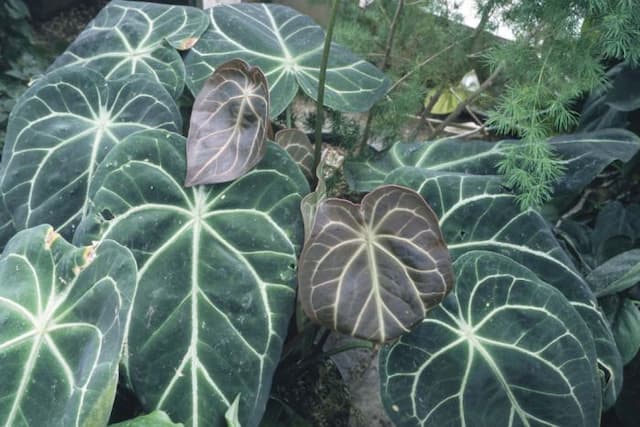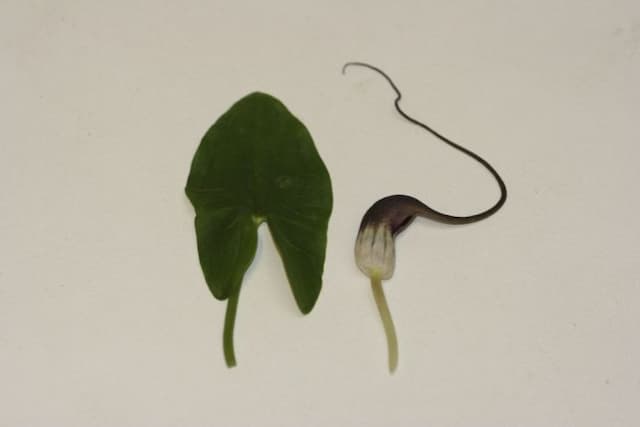Pistia stratiotes

ABOUT
The plant known as water lettuce, has a distinctive appearance characterized by its floating rosette of light green, velvety leaves. The leaves are broad and rounded with deeply wavy or ruffled edges resembling heads of lettuce floating on the water surface. The veins on the leaves are prominent and give the plant a ribbed texture. The underbelly of each leaf typically has many hair-like structures, which hang into the water and further aid buoyancy. Water lettuce may produce small, inconspicuous flowers that are hidden amongst the leaves but these are rarely seen. Moreover, this plant often forms dense colonies, with the individual rosettes connected to each other by slender horizontal stems that are not easily visible above the water.
About this plant
 Names
NamesFamily
Araceae.
Synonyms
Water Lettuce, Nile Cabbage, Shellflower, Water Cabbage, Tropical Duckweed.
Common names
Apiospermum obcordatum, Pistia crispata, Pistia obcordata, Pistia occidentalis, Pistia spathulata.
 Toxicity
ToxicityTo humans
The plant known as water lettuce (Pistia stratiotes) is not commonly reported as toxic to humans. However, care should be taken as some people might have allergic reactions or skin irritation upon contact with the sap of the plant. It is important to note that ingestion of any part of this plant is not recommended, as it is not considered edible. While it does not contain well-known toxic compounds, eating water lettuce might cause gastrointestinal discomfort or other non-specific symptoms due to the plant's potential contamination with microorganisms or parasites from the water it grows in.
To pets
Water lettuce (Pistia stratiotes) is not typically known to be toxic to pets. However, as with humans, consuming this plant could lead to gastrointestinal upset in pets due to its potential for harboring bacteria or parasites. It is best to prevent pets from ingesting water lettuce to avoid any possible digestive issues. If your pet ingests parts of this plant and shows signs of distress, consult with a veterinarian.
 Characteristics
CharacteristicsLife cycle
Perennials
Foliage type
Evergreen
Color of leaves
Green
Height
0-1 feet (0-0.3 meters)
Spread
1-5 feet (0.3-1.5 meters)
Plant type
Herb
Hardiness zones
9-11
Native area
South America
Benefits
 General Benefits
General Benefits- Water filtration: Pistia stratiotes helps remove nitrogen and phosphorus, which can improve water quality in aquatic environments.
- Habitat creation: It provides a habitat for aquatic life, including microorganisms, insects, and small fish.
- Food source: The plant is a valuable food source for many species of fish and birds.
- Erosion control: The plant's roots help to stabilize banks and substrates, reducing erosion in water bodies.
- Shade provider: It offers shade to aquatic organisms, helping to regulate water temperature and protect them from predators.
- Aesthetic value: With its rosette of floating leaves, Water Lettuce adds a decorative element to ponds and water gardens.
 Medical Properties
Medical Properties- Pistia stratiotes, commonly known as water lettuce, is traditionally used in some cultures to treat skin conditions and diseases, providing a soothing effect when applied topically.
- The plant is also known for its antimicrobial properties, potentially defending against bacterial and fungal infections.
- In folk medicine, water lettuce has been used to aid in the treatment of gastrointestinal disorders, such as dysentery and diarrhea.
- Water lettuce may possess analgesic properties, helping to reduce pain in various conditions.
- Some communities use this plant to help manage symptoms of arthritis, owing to its anti-inflammatory effects.
- In some traditional practices, extracts of water lettuce are utilized for their sedative effects, potentially helping with sleep disorders and promoting relaxation.
- The plant is sometimes used for its purported antitoxic effects, especially in cases of snakebites and insect stings, although scientific support for this is limited.
 Air-purifying Qualities
Air-purifying QualitiesThis plant is not specifically known for air purifying qualities.
 Other Uses
Other Uses- Pistia stratiotes, commonly known as water lettuce, serves as food for fish and other wildlife in its natural habitat, providing crucial sustenance and acting as a foundational part of the food chain.
- Water lettuce can be used as a living mulch in water gardens, helping to reduce algae growth by shading the water and absorbing excess nutrients.
- The plant has been traditionally used as an insulating material due to its buoyant and fibrous nature, utilizing the dead dried leaves to pad fragile cargo or insulate dwellings.
- Research has suggested that water lettuce could be an efficient bioindicator of aquatic pollution, indicating the health of an ecosystem through its growth conditions and morphological changes.
- Craftspeople have used dried water lettuce leaves to create sustainable, biodegradable handicrafts such as baskets and mats, tapping into its natural weavability.
- In some areas, the fibrous nature of water lettuce makes it a suitable material for composting, adding valuable organic matter and nutrients back into the soil.
- The dense mats formed by water lettuce can be utilized as a natural erosion control method in waterways, reducing shoreline erosion by damping wave action and water flow.
- Water lettuce acts as a nursery area for juvenile fish and amphibians, providing cover and protection from predators in the dense roots and leaves.
- Some communities have experimented with using water lettuce to create green roofs, taking advantage of its low soil and nutrient requirements to cover buildings with vegetation.
- Fish farmers sometimes use water lettuce to provide shade in aquaculture ponds, helping to regulate water temperature and thus creating a more hospitable environment for the farmed species.
Interesting Facts
 Feng Shui
Feng ShuiThe Water Lettuce is not used in Feng Shui practice.
 Zodiac Sign Compitability
Zodiac Sign CompitabilityThe Water Lettuce is not used in astrology practice.
 Plant Symbolism
Plant Symbolism- Peace: Known commonly as water lettuce, Pistia stratiotes often creates a calming, green carpet across the surfaces of ponds and still waters, symbolizing peace and tranquility.
- Abundance: Water lettuce is a fast-growing plant that can quickly cover the surface of water bodies, representing abundance and profusion.
- Adaptability: As a floating aquatic plant, water lettuce adapts easily to various water conditions, symbolizing flexibility and the ability to thrive in different environments.
- Protection: In some ecosystems, water lettuce provides a habitat for aquatic life, offering shelter and shade, which symbolizes protection and nurturing.
 Water
WaterWater Lettuce, commonly known as Pistia stratiotes, naturally grows in aquatic environments, so rather than traditional watering, it requires a consistent aquatic habitat. Ensure that Water Lettuce has a continuous supply of water by maintaining its environment, such as a pond or water garden. Since it floats on the surface of the water, the roots absorb nutrients and moisture directly from the water. Check the water levels weekly and add more to keep the habitat from drying out, ensuring that the plants are always afloat. Water Lettuce typically does not require additional water beyond its aquatic setting, and there is no fixed amount of water needed as it varies depending on the size of the pond or container.
 Light
LightWater Lettuce thrives in bright, indirect light as direct sunlight can cause the leaves to burn, especially during the hottest part of the day. The plant prefers a position where it can receive morning sunlight and partial shade during the peak afternoon hours. Ideal light conditions include dappled sunlight or light filtered through a curtain of trees or other vegetation.
 Temperature
TemperatureWater Lettuce fares best in warm temperatures, with an optimal range between 70 to 85 degrees Fahrenheit. The plant can survive in temperatures as low as 50 degrees Fahrenheit, but growth will be significantly reduced. Prolonged exposure to temperatures below this minimum or above 90 degrees Fahrenheit can be detrimental to the plant's health.
 Pruning
PruningPruning Water Lettuce is primarily for controlling its growth and removing any brown or decaying leaves to maintain the health and appearance of the plant. Trim away excess growth and dead material as needed, typically every few weeks during the growing season. The best time for pruning is in the spring and summer months, when the plant is actively growing.
 Cleaning
CleaningNot needed
 Soil
SoilWater Lettuce thrives in a soilless environment, as it is an aquatic plant that prefers to float on the surface of still or slow-moving water bodies. The best 'soil' mix for Water Lettuce is not soil at all, but clean, freshwater with a pH between 6.5 and 7.2, rich in nutrients either from fish waste or liquid plant fertilizer.
 Repotting
RepottingWater Lettuce does not require repotting in the traditional sense, as it is not grown in soil. It freely floats on the water surface, forming new offshoots. Instead of repotting, simply thin out the plants as needed to prevent overcrowding in the pond or aquarium.
 Humidity & Misting
Humidity & MistingWater Lettuce naturally thrives in high humidity conditions, as it is a floating aquatic plant. It requires a high humidity environment, ideally above 70%, which is naturally provided by its natural habitat over a body of water.
 Suitable locations
Suitable locationsIndoor
Keep Water Lettuce in a water-filled container under bright, indirect light.
Outdoor
Float Water Lettuce in a pond with partial sunlight and still water.
Hardiness zone
9-11 USDA
 Life cycle
Life cycleWater lettuce (Pistia stratiotes) begins its life cycle when mature plants produce small, inconspicuous flowers that are typically hidden within the leaf bases. From these flowers, seeds develop, which can fall into the water and remain dormant until conditions are favorable. When they sprout, the tiny seedlings quickly grow into larger floating rosettes, with heavily ridged, waxy, and water-repellent leaves that aid in buoyancy and prevent soaking. These rosettes are initially independent, but as they mature, they produce stolons (horizontal stems) that generate daughter plants, allowing for vegetative reproduction and forming dense mats. The plant's roots dangle underwater and absorb nutrients directly from the water column, supporting rapid growth in nutrient-rich environments. Water lettuce continues this cycle of vegetative growth and occasional sexual reproduction, with individual plants capable of surviving for several months to a few years if conditions allow.
 Propogation
PropogationPropogation time
Spring-Summer
The most popular method of propagation for water lettuce, or Pistia stratiotes, is vegetative reproduction through the division of daughter plants. Water lettuce produces small offsets that form a rosette of leaves, which can be gently pulled apart from the mother plant. The best time for this process is during the warm growing season, when the plant's growth is most vigorous, typically between late spring and early summer. These offsets, once separated, can be floated on the surface of the water in a new location. It's important to ensure that the daughter plants have a few roots to start with; this enhances the chance of successful establishment. Given the right conditions, including warm temperatures, adequate light, and nutrient-rich water, the new plants will quickly take root and grow, continuing to propagate and cover the available water surface.









